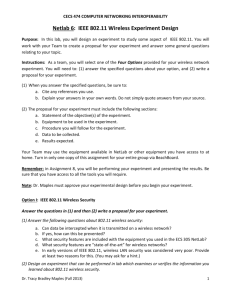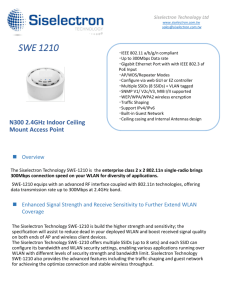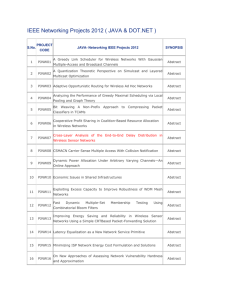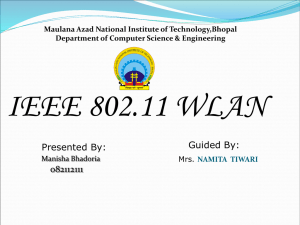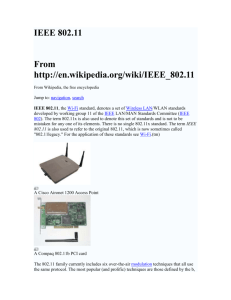Caleb Howell
advertisement
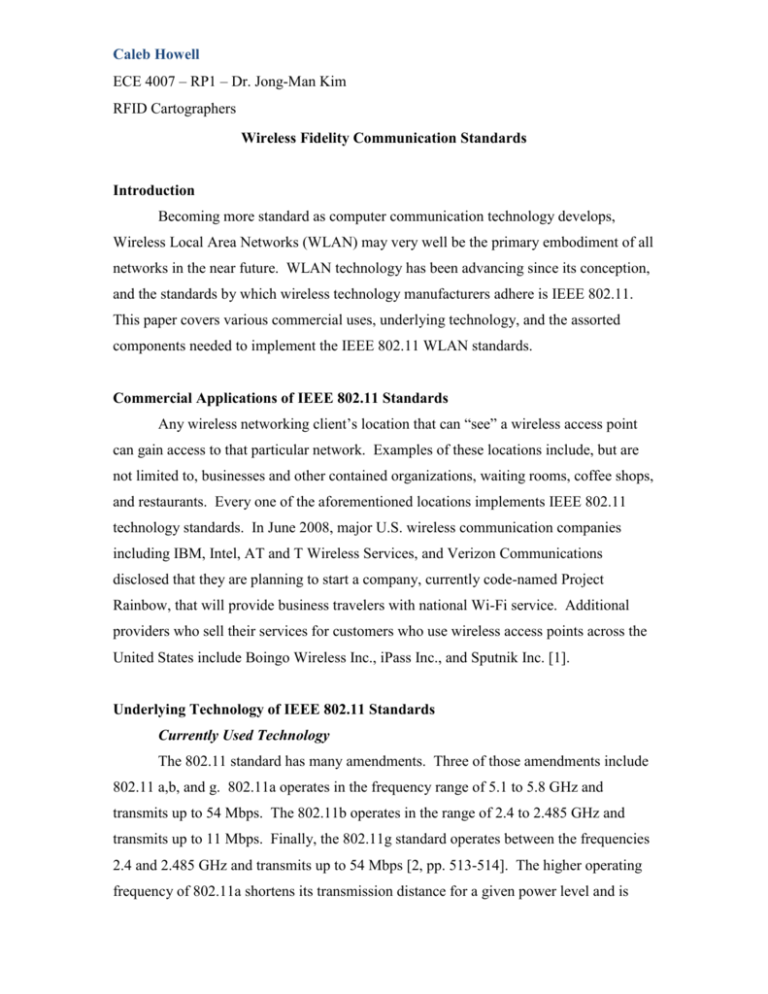
Caleb Howell ECE 4007 – RP1 – Dr. Jong-Man Kim RFID Cartographers Wireless Fidelity Communication Standards Introduction Becoming more standard as computer communication technology develops, Wireless Local Area Networks (WLAN) may very well be the primary embodiment of all networks in the near future. WLAN technology has been advancing since its conception, and the standards by which wireless technology manufacturers adhere is IEEE 802.11. This paper covers various commercial uses, underlying technology, and the assorted components needed to implement the IEEE 802.11 WLAN standards. Commercial Applications of IEEE 802.11 Standards Any wireless networking client’s location that can “see” a wireless access point can gain access to that particular network. Examples of these locations include, but are not limited to, businesses and other contained organizations, waiting rooms, coffee shops, and restaurants. Every one of the aforementioned locations implements IEEE 802.11 technology standards. In June 2008, major U.S. wireless communication companies including IBM, Intel, AT and T Wireless Services, and Verizon Communications disclosed that they are planning to start a company, currently code-named Project Rainbow, that will provide business travelers with national Wi-Fi service. Additional providers who sell their services for customers who use wireless access points across the United States include Boingo Wireless Inc., iPass Inc., and Sputnik Inc. [1]. Underlying Technology of IEEE 802.11 Standards Currently Used Technology The 802.11 standard has many amendments. Three of those amendments include 802.11 a,b, and g. 802.11a operates in the frequency range of 5.1 to 5.8 GHz and transmits up to 54 Mbps. The 802.11b operates in the range of 2.4 to 2.485 GHz and transmits up to 11 Mbps. Finally, the 802.11g standard operates between the frequencies 2.4 and 2.485 GHz and transmits up to 54 Mbps [2, pp. 513-514]. The higher operating frequency of 802.11a shortens its transmission distance for a given power level and is easily obstructed, but it transmits at a very high rate. In contrast, 802.11b operates at a lower frequency allowing it to transmit a greater distance than 802.11a and more easily penetrate walls, but its transmitting rate is lower. 802.11g is basically a combination of 802.11a and 802.11b. Its operating frequency is lower hence a greater transmission distance, and its rate of data transmission is extremely fast. The only drawbacks of 802.11g are that, like 802.11b, appliances can interfere with the signal because of the frequency range, and 802.11g costs more to implement than the other two [3]. All three of the standards share many characteristics and all use the same medium access protocol, CSMA/CA. Additionally, they all have the ability to extend to greater distances by reducing their transmission rate [2, pp. 513-514]. There are eight total finalized amendments to the 802.11 standard. On March 8, 2007, all eight amendments were combined into one document. It is called IEEE 802.112007 and is the single most modern official document available that contains all amendments to the 802.11 wireless communication standard [4]. Upcoming Technology The newest version of the 802.11 series is the 802.11n. This new standard increases the wireless network data transmission rate to over 100 Mbps, because it implements the new MIMO technology which uses multiple wireless signals and antennas instead of one [5]. By way of increased signal intensity, 802.11n also transmits a greater distance than previous standards. The drawbacks of 802.11n are that 802.11b/g based networks may be subject to interference from the multiple signals that 802.11n uses, n technology costs more than the other standards, and the standard is not finalized. An example in the differing costs of n and g notebook card technology sold by Belkin is $70 and $35 respectively, where n is double the price of g [6]. IEEE 802.11 Implementation When implementing the IEEE 802.11 standard, both software and hardware are requirements for functionality. The architecture for 802.11 is comprised of one or more basic service sets (BSSs). Each BSS contains a central base station, frequently called an access point, and one or more wireless stations or clients. All BSSs are connected to a single interconnection device, for example, a router [2, p. 514]. The software aspect of IEEE 802.11 implementation includes a multiple access protocol (MAC). A wireless client can begin sending and receiving data frames to and from the access point once it has associated itself with that access point, but problems can arise when multiple clients attempt transmitting data frames simultaneously over the same channel. This is where the MAC is implemented in coordinating the transmissions. The most commonly used MAC in wireless networks is called carrier sense multiple access with collision avoidance (CSMA/CA) [2, p. 517]. As previously mentioned, 802.11n, once standardization is complete, is supposed to achieve a transmission rate of 100 Mbps. Two theories are implemented to achieve that goal: improve MAC efficiency, and increase the peak data rate well beyond 100 Mbps. Much of this is accomplished by MIMO technology which boosts the data rate through parallel antenna transmission of multiple spatial streams [7]. [1] J. Blau, “Wi-Fi Hotspot Networks Sprout Like Mushrooms,” IEEE Spectr. Online. [Online]. Available: http://www.spectrum.ieee.org/archive/1505. [Accessed Aug. 31, 2008] [2] J. F. Kurose and K. W. Ross, Computer Networking: A top-down approach featuring the internet, 3rd ed. Boston, MA: Addison Wesley, 2005, pp. 513-528. [3] B. Mitchell, “Wireless Standards - 802.11b 802.11a 802.11g and 802.11n: The 802.11 family explained,” About.com. [Online]. Available: http://compnetworking.about.com/cs/wireless80211/a/aa80211standard.htm. [Accessed: Sept. 2, 2008] [4] IEEE Standard for Information Technology-Telecommunications and information exchange between systems-Local and metropolitan area networks-Specific requirements - Part 11: Wireless LAN Medium Access Control (MAC) and Physical Layer (PHY) Specifications, IEEE Standard 802.11-2007, June 12, 2007. [5] S. J. Vaughan-Nichols, “Will the new wi-fi fly,” Computer, vol. 39, no. 10, pp. 16-18, Oct. 2006. [Online]. IEEE Xplore, http://ieeexplore.ieee.org.www.library.gatech.edu:2048/iel5/2/36033/01707628.p df?isnumber=36033&prod=JNL&arnumber=1707628&arSt=16&ared=18&arAut hor=Vaughan-Nichols%2C+S.J.. [Accessed: Sept. 1, 2008] [6] “Networking Components / Wireless Networking,” Belkin International, Inc., [Online]. Available: http://catalog.belkin.com/IWCatSectionView.process?Section_Id=200340. [Accessed: Sept. 1, 2008] [7] J. Lorincz and D. Bequsic, “Physical Layer Analysis Emerging IEEE 802.11n WLAN Standard,” presented at the 8th Int. Conf., FESB-Split, Split Univ., Croatia, Feb. 20-22, 2006.
